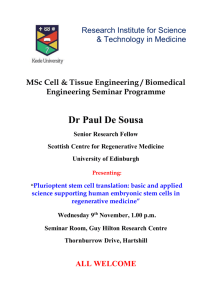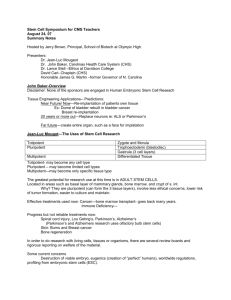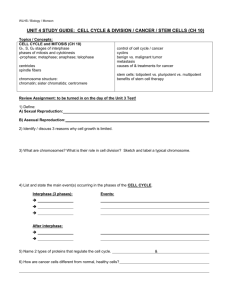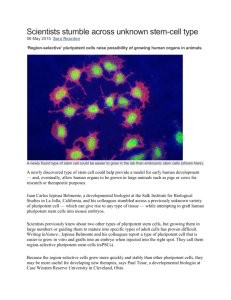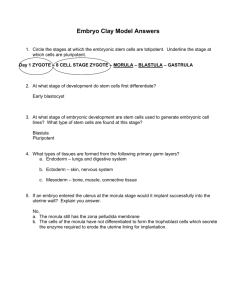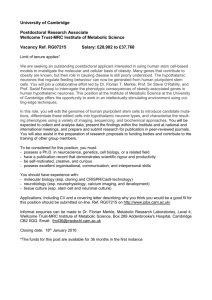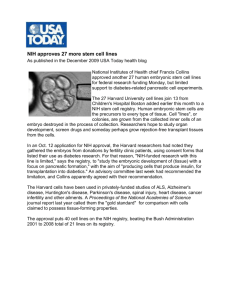Exam #1 - PrismNet
advertisement
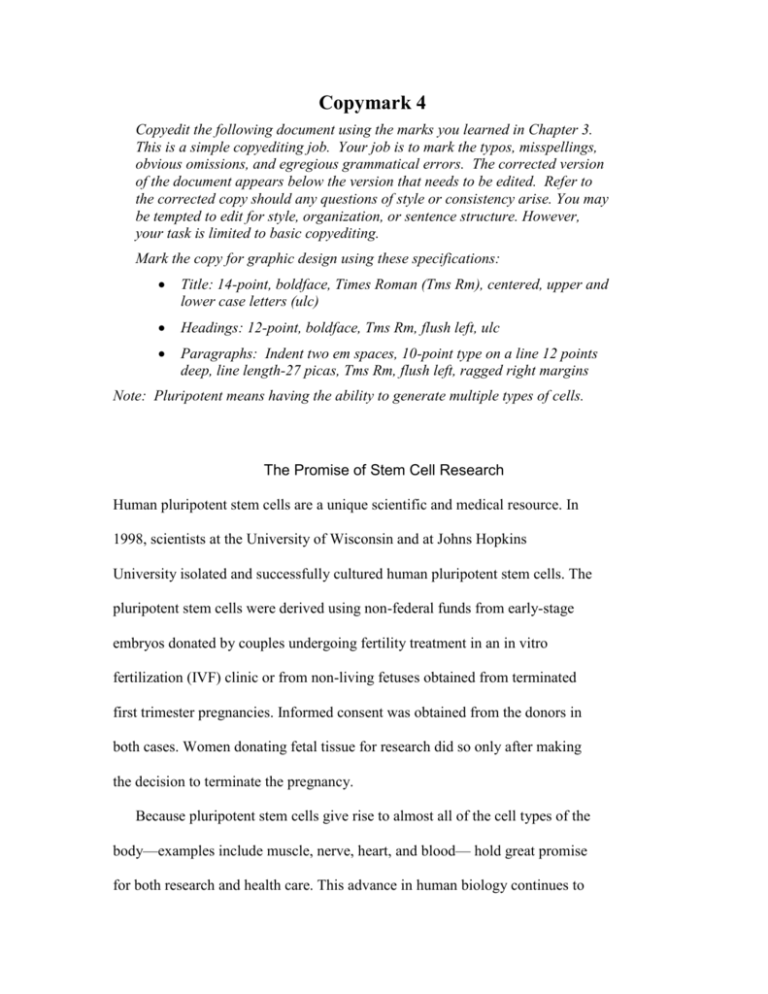
Copymark 4 Copyedit the following document using the marks you learned in Chapter 3. This is a simple copyediting job. Your job is to mark the typos, misspellings, obvious omissions, and egregious grammatical errors. The corrected version of the document appears below the version that needs to be edited. Refer to the corrected copy should any questions of style or consistency arise. You may be tempted to edit for style, organization, or sentence structure. However, your task is limited to basic copyediting. Mark the copy for graphic design using these specifications: Title: 14-point, boldface, Times Roman (Tms Rm), centered, upper and lower case letters (ulc) Headings: 12-point, boldface, Tms Rm, flush left, ulc Paragraphs: Indent two em spaces, 10-point type on a line 12 points deep, line length-27 picas, Tms Rm, flush left, ragged right margins Note: Pluripotent means having the ability to generate multiple types of cells. The Promise of Stem Cell Research Human pluripotent stem cells are a unique scientific and medical resource. In 1998, scientists at the University of Wisconsin and at Johns Hopkins University isolated and successfully cultured human pluripotent stem cells. The pluripotent stem cells were derived using non-federal funds from early-stage embryos donated by couples undergoing fertility treatment in an in vitro fertilization (IVF) clinic or from non-living fetuses obtained from terminated first trimester pregnancies. Informed consent was obtained from the donors in both cases. Women donating fetal tissue for research did so only after making the decision to terminate the pregnancy. Because pluripotent stem cells give rise to almost all of the cell types of the body—examples include muscle, nerve, heart, and blood— hold great promise for both research and health care. This advance in human biology continues to generate enthusiasm among scientists; patients who sufferfrom a broad range of diseases, including cancer, heart disease and diabetes; and their families. For example, further research using human pluripotent stem cells may help: Generate cells and tissue for transplantation. Pluripotent stem cells have the potential to develop into specialized cells that could be used as replacement cells and tissues to treat many diseases and conditions, including Parkinson’s disease, spinal cord injury, stroke, burns, heart disease, diabetes, osteoarthritis, and rheumatoid arthritis. Improve our understanding of the complex events that occur during normal human development and also help us understand what causes birth defects and cancer. Change the way we develop drugs and test them for safety. Rather than evaluating the safety of candidate drugs in an animal model, drugs might be initially tested on cells developed from pluripotent stem cells, and only the safest candidate drugs would advance to animal and then human testing. The Need for Guidelines to Govern Research Using Pluripotent Stem Cells The National Institutes of Health (NIH) is prohibited from using any appropriated funds for "(1) the creation of a human embryo or embryos for research purposes or (2) research in which a human embryo or embryos are destroyed, discarded, or knowingly subjected to risk of injury or death greater than that allowed for research on fetuses in utero under 45 CFR 46.208(a)(2) and section 498(b) of the Public Health Service Act (42 U.S.C. 289g(b))." Because of the enormous potential of human pluripotent stem cells to medical research, the NIH asked the General Council of the Department of Health and Human Services (HHS) to determine whether research utilizing pluripotent stem cells is permissible under existing federal law governing embryo and fetal tissue research. After careful consideration, the HHS concluded that because human pluripotent cells are not embryos, current federal law does not prohibit HHS funds from being used for research utilizing these cells. Recognizing the ethical and legal issues surrounding human pluripotent stem cell research and the need for stringent oversight of this class of research— oversight that goes beyond the traditional rigorous NIH scientific peer review process—the NIH issued a moratorium on the funding of this research until guidelines could be developed and an oversight process could be implemented. In April 1989, the NIH convened a working group of the Advisory Committee to the Director (ACD), NIH, to provide advice to the ACD revelant to guidelines and oversight for this research. The working group met in public session and included scientists, clinicians, ethicists, lawyers, patients, and patient advocates. During its deliberations, the group considered advice from the National Bioethics Commission, the public, and scientists. Draft guidelines for this research were published for public comment, and, after reviewing and considering all comments received, the NIH Guidelines for Research Using Human Pluripotent Stem Cells NIH Guidelines) was published in the Federal Register and became effective on August 25, 2000. Specifics of the Guidelines The purpose of the NIH Guidelines is to set forth procedures to help ensure that NIH-funded research in this area is conducted in an ethical and legal manner. By issuing these guidelines, the NIH aims to enhance both the scientific and ethical oversight of this important arena of research and the pace at which scientists can explore its many promises. These guidelines will encourage openness, provide appropriate federal oversight, help make certain that all researchers can make use of these critical research tools, and help assure full public access to the practical medical benefits of research using these cells.

